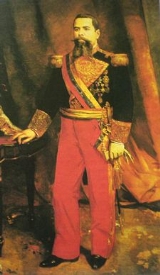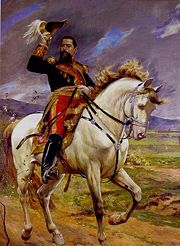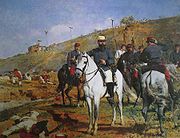
Joaquín Crespo
Encyclopedia
Joaquín Sinforiano de Jesús Crespo Torres (xoaˈkin siɱfoˈrjano ðe xeˈsus ˈkɾespo ˈtores; 22 August 1841 – 16 April 1898) was a politician, soldier, a member of the Great Liberal Party of Venezuela
and President of Venezuela from 1884 to 1886 and again from 1892 to 1898. During the second Joaquín Crespo regime, the Venezuela Crisis of 1895
saw Venezuela
's longstanding dispute with Great Britain
about the territory of Guayana Esequiba
, which Britain claimed as part of British Guiana
and Venezuela saw as Venezuelan territory, come to a head. An international arbitral panel ultimately awarded most of the territory to Britain.
, the widow of Ramón Silva. Crespo began in politics as deputy to the Legislative Assembly of Guarico in the same year, being the principal deputy of the state at the National Congress (1865–1868). After completing his term, he joined José Tadeo Monagas
(being one of main supporters of Antonio Guzmán Blanco
in combat against the Revolución Azul) (Blue Revolution) (1868–1870).
Crespo is soon elevated to the rank of General in Chief of the Venezuelan Army in 1871. With the support of Guzmán Blanco, his political and military career rises in short time. In quick succession he is designated as military and civilian chief of Guarico in 1871, second appointed of the Presidency of Venezuela in 1873, president of Guarico state in 1874, and, between 1876 until 1877, minister of war and navy. In 1879, Crespo was one of the political figures that claimed the return of government power to Guzmán Blanco, and was named civilian and military Chief of Maracay
in 1880 and president of Guzmán Blanco state in 1882.

 On 14 April 1884 Crespo was elected president of Venezuela by the Federal Council. Also in 1884, under the direction of Giussepi Orsi, Crespo started the construction of the Miraflores Palace for his family. He took office on 26 April 1884 and served until 15 September 1886, being succeeded by his predecessor Antonio Guzmán Blanco
On 14 April 1884 Crespo was elected president of Venezuela by the Federal Council. Also in 1884, under the direction of Giussepi Orsi, Crespo started the construction of the Miraflores Palace for his family. He took office on 26 April 1884 and served until 15 September 1886, being succeeded by his predecessor Antonio Guzmán Blanco
. After this, the Congress rewarded his loyalty with the title of Héroe del Deber Cumplido (Hero of Fulfilled Duties) on 29 April 1886. In 1888, after the political reactions against Guzmán prompted by president Juan Pablo Rojas Paul
, Crespo decided to travel to Trinidad
where he made preparations for an uprising. The attempt failed, however, and he was arrested aboard the schooner
Ana Jacinta and transferred to La Rotunda jail in Caracas
before being exiled. Senator for Guárico (1890–1892), he opposed the constitutional reform promoted by president Raimundo Andueza Palacio
Crespo was the main leader of the Revolución Legalista (Legalist Revolution) in 1892, and retook the Presidency on 7 October 1892. In the words of Thomas Rourke, the second presidency of Crespo, which continued for six years after the revolution that had put him into power, was simply a repetition of the two years he had been in power before, or even worse. Crespo acted as dictator, created new debts for the nation, ruined the foreign credit of the merchants, getting funds from Germany to pay the debts of the railroad, but most of the money found its way into the pockets of his friends.
In 1895 the Venezuela Crisis of 1895
saw Venezuela
's longstanding dispute with Great Britain
about the territory of Guayana Esequiba
, which Britain claimed as part of British Guiana
and Venezuela saw as Venezuelan territory, come to a head. As the dispute became a crisis, the key issue became Britain's refusal to include in the proposed international arbitration the territory east of the "Schomburgk Line", which a surveyor had drawn half a century earlier as a boundary between Venezuela and the former Dutch territory of British Guiana. The crisis ultimately saw Britain accept the United States' intervention in the dispute to force arbitration of the entire disputed territory, and tacitly accept the United States' right to intervene under the Monroe Doctrine
. A tribunal convened in Paris in 1898 to decide the matter, and in 1899 awarded the bulk of the disputed territory to British Guiana.
On 16 June 1893 new constitution is established, the major changes being the increase of the presidential term from two for four years, and direct suffrage. In February 1894 Crespo obtained 349,447 votes at the presidential elections.
for the presidential elections of September, 1898. However, Andrade's victory at the elections was fraudulent, causing the eruption of an armed movement led by General José Manuel "Mocho" Hernández, known as Queipa Revolution. For this reason, Crespo in his role as leader of the Army decides to destroy the uprising, being killed at La Mata Carmelera (Cojedes
). Crespo, like many major figures of Venezuelan history, was linked to Freemasonry
, being mason in the 33rd degree. Crespo was buried at the Southern General Cemetery of Caracas, in a private mausoleum on 24 April 1898. An obituary listed him as "killed in battle."
Great Liberal Party of Venezuela
The Great Liberal Party of Venezuela was a political party in Venezuela, founded on August 21, 1840 by Antonio Leocadio Guzmán and Tomás Lander, through an editorial published by Guzmán at El Venezolano newspaper....
and President of Venezuela from 1884 to 1886 and again from 1892 to 1898. During the second Joaquín Crespo regime, the Venezuela Crisis of 1895
Venezuela Crisis of 1895
The Venezuela Crisis of 1895 occurred over Venezuela's longstanding dispute with the United Kingdom about the territory of Guayana Esequiba, which Britain claimed as part of British Guiana and Venezuela saw as Venezuelan territory...
saw Venezuela
Venezuela
Venezuela , officially called the Bolivarian Republic of Venezuela , is a tropical country on the northern coast of South America. It borders Colombia to the west, Guyana to the east, and Brazil to the south...
's longstanding dispute with Great Britain
Great Britain
Great Britain or Britain is an island situated to the northwest of Continental Europe. It is the ninth largest island in the world, and the largest European island, as well as the largest of the British Isles...
about the territory of Guayana Esequiba
Guayana Esequiba
Guayana Esequiba is a territory administered by Guyana but claimed by Venezuela. It includes the territory between the Cuyuni River to the west and the Essequibo River to the east...
, which Britain claimed as part of British Guiana
British Guiana
British Guiana was the name of the British colony on the northern coast of South America, now the independent nation of Guyana.The area was originally settled by the Dutch at the start of the 17th century as the colonies of Essequibo, Demerara, and Berbice...
and Venezuela saw as Venezuelan territory, come to a head. An international arbitral panel ultimately awarded most of the territory to Britain.
Background and early career
Son of Leandro Crespo and María Aquilina Torres, Joaquín Crespo was born in San Francisco de Cara, lived his youth in Parapara, town of Guarico state, where he learned to read and write. His career in the military began in March, 1858 as a soldier under the command of Colonels José de Jesus, Donato Rodríguez and Zoilo Medrano. He rose to brigadier general on 17 March 1864. On 18 September 1864, he was married (in Parapara) to Jacinta ParejoJacinta Parejo
Jacinta Parejo de Crespo, was the wife of Venezuelan president and military leader Joaquín Crespo....
, the widow of Ramón Silva. Crespo began in politics as deputy to the Legislative Assembly of Guarico in the same year, being the principal deputy of the state at the National Congress (1865–1868). After completing his term, he joined José Tadeo Monagas
José Tadeo Monagas
José Tadeo Monagas Burgos was President of Venezuela 1847-1851 and 1855–1858, and a hero of the Venezuelan War of Independence...
(being one of main supporters of Antonio Guzmán Blanco
Antonio Guzmán Blanco
Antonio Leocadio Guzmán Blanco was President of Venezuela for three separate terms, from 1870–1877, from 1879–1884, and from 1886–1887....
in combat against the Revolución Azul) (Blue Revolution) (1868–1870).
Crespo is soon elevated to the rank of General in Chief of the Venezuelan Army in 1871. With the support of Guzmán Blanco, his political and military career rises in short time. In quick succession he is designated as military and civilian chief of Guarico in 1871, second appointed of the Presidency of Venezuela in 1873, president of Guarico state in 1874, and, between 1876 until 1877, minister of war and navy. In 1879, Crespo was one of the political figures that claimed the return of government power to Guzmán Blanco, and was named civilian and military Chief of Maracay
Maracay
Maracay is a city in north-central Venezuela, near the Caribbean coast, and is the capital and most important city of the state of Aragua. Most of it falls under the jurisdiction of the Girardot Municipality. The population as per the 2001 census was 750,000...
in 1880 and president of Guzmán Blanco state in 1882.
Presidencies


Antonio Guzmán Blanco
Antonio Leocadio Guzmán Blanco was President of Venezuela for three separate terms, from 1870–1877, from 1879–1884, and from 1886–1887....
. After this, the Congress rewarded his loyalty with the title of Héroe del Deber Cumplido (Hero of Fulfilled Duties) on 29 April 1886. In 1888, after the political reactions against Guzmán prompted by president Juan Pablo Rojas Paul
Juan Pablo Rojas Paúl
Juan Pablo Rojas Paúl was President of Venezuela from 1888 to 1890. He was the first civilian president who was elected by constitutional procedures in 50 years, and the only one who could finish his term properly, until 74 years later.Elected by Antonio Guzmán like his successor, Rojas tried to...
, Crespo decided to travel to Trinidad
Trinidad
Trinidad is the larger and more populous of the two major islands and numerous landforms which make up the island nation of Trinidad and Tobago. It is the southernmost island in the Caribbean and lies just off the northeastern coast of Venezuela. With an area of it is also the fifth largest in...
where he made preparations for an uprising. The attempt failed, however, and he was arrested aboard the schooner
Schooner
A schooner is a type of sailing vessel characterized by the use of fore-and-aft sails on two or more masts with the forward mast being no taller than the rear masts....
Ana Jacinta and transferred to La Rotunda jail in Caracas
Caracas
Caracas , officially Santiago de León de Caracas, is the capital and largest city of Venezuela; natives or residents are known as Caraquenians in English . It is located in the northern part of the country, following the contours of the narrow Caracas Valley on the Venezuelan coastal mountain range...
before being exiled. Senator for Guárico (1890–1892), he opposed the constitutional reform promoted by president Raimundo Andueza Palacio
Crespo was the main leader of the Revolución Legalista (Legalist Revolution) in 1892, and retook the Presidency on 7 October 1892. In the words of Thomas Rourke, the second presidency of Crespo, which continued for six years after the revolution that had put him into power, was simply a repetition of the two years he had been in power before, or even worse. Crespo acted as dictator, created new debts for the nation, ruined the foreign credit of the merchants, getting funds from Germany to pay the debts of the railroad, but most of the money found its way into the pockets of his friends.
In 1895 the Venezuela Crisis of 1895
Venezuela Crisis of 1895
The Venezuela Crisis of 1895 occurred over Venezuela's longstanding dispute with the United Kingdom about the territory of Guayana Esequiba, which Britain claimed as part of British Guiana and Venezuela saw as Venezuelan territory...
saw Venezuela
Venezuela
Venezuela , officially called the Bolivarian Republic of Venezuela , is a tropical country on the northern coast of South America. It borders Colombia to the west, Guyana to the east, and Brazil to the south...
's longstanding dispute with Great Britain
Great Britain
Great Britain or Britain is an island situated to the northwest of Continental Europe. It is the ninth largest island in the world, and the largest European island, as well as the largest of the British Isles...
about the territory of Guayana Esequiba
Guayana Esequiba
Guayana Esequiba is a territory administered by Guyana but claimed by Venezuela. It includes the territory between the Cuyuni River to the west and the Essequibo River to the east...
, which Britain claimed as part of British Guiana
British Guiana
British Guiana was the name of the British colony on the northern coast of South America, now the independent nation of Guyana.The area was originally settled by the Dutch at the start of the 17th century as the colonies of Essequibo, Demerara, and Berbice...
and Venezuela saw as Venezuelan territory, come to a head. As the dispute became a crisis, the key issue became Britain's refusal to include in the proposed international arbitration the territory east of the "Schomburgk Line", which a surveyor had drawn half a century earlier as a boundary between Venezuela and the former Dutch territory of British Guiana. The crisis ultimately saw Britain accept the United States' intervention in the dispute to force arbitration of the entire disputed territory, and tacitly accept the United States' right to intervene under the Monroe Doctrine
Monroe Doctrine
The Monroe Doctrine is a policy of the United States introduced on December 2, 1823. It stated that further efforts by European nations to colonize land or interfere with states in North or South America would be viewed as acts of aggression requiring U.S. intervention...
. A tribunal convened in Paris in 1898 to decide the matter, and in 1899 awarded the bulk of the disputed territory to British Guiana.
On 16 June 1893 new constitution is established, the major changes being the increase of the presidential term from two for four years, and direct suffrage. In February 1894 Crespo obtained 349,447 votes at the presidential elections.
Death
In 1897 Crespo endorsed the candidature of Ignacio AndradeIgnacio Andrade
Ignacio Andrade Troconis , was a military and politician, member of the Liberal yellow party, President of Venezuela 1898–1899, his election was declaredly clouded by fraud.- Early life and career :...
for the presidential elections of September, 1898. However, Andrade's victory at the elections was fraudulent, causing the eruption of an armed movement led by General José Manuel "Mocho" Hernández, known as Queipa Revolution. For this reason, Crespo in his role as leader of the Army decides to destroy the uprising, being killed at La Mata Carmelera (Cojedes
Cojedes (state)
Cojedes State is one of the 23 states of Venezuela. The state capital is San Carlos.Cojedes State covers a total surface area of 14,800 km² and, in 2007, had an estimated population of 300,300.- History :...
). Crespo, like many major figures of Venezuelan history, was linked to Freemasonry
Freemasonry
Freemasonry is a fraternal organisation that arose from obscure origins in the late 16th to early 17th century. Freemasonry now exists in various forms all over the world, with a membership estimated at around six million, including approximately 150,000 under the jurisdictions of the Grand Lodge...
, being mason in the 33rd degree. Crespo was buried at the Southern General Cemetery of Caracas, in a private mausoleum on 24 April 1898. An obituary listed him as "killed in battle."

